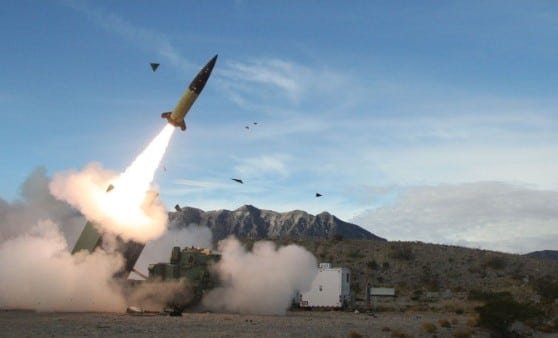For the first time According to three U.S. officials, Ukraine’s military has already used the potent long-range ballistic missiles that the United States initially gave it earlier this month twice against Russian soldiers.
According to the officials, the first hit occurred on April 17 in the morning and was directed towards a Russian military airfield around 100 kilometers inside Crimea’s border. Tuesday night, the Ukrainian military launched its second use of the Army Tactical Missile System (ATACMS), supplied by the United States, on Russian soldiers east of the town of Berdyansk in Zaporizhzhia Oblast in southeast Ukraine, according to officials.
A representative for the National Security Council verified that the United States has sent ATACMS to Ukraine, even though the Biden administration has not previously acknowledged doing so. They were included in the
The revelation that Ukraine has used the long-range ATACMS came as Biden signed into law a foreign aid package providing billions of dollars in weapons and support to Ukraine, Israel and Taiwan. The measure, which will provide about $61 billion for Ukraine, was hung up for months due to opposition in the Republican-led House.
The Biden administration was already preparing a military aid package for Ukraine worth more than $1 billion, according to two U.S. officials familiar with the planning. It will include a range of equipment that the U.S. has already provided Ukraine, including ammunition, stinger missiles, artillery rounds, infantry fighting vehicles and other military equipment, the officials said.
NBC News was first to report in February that the Biden administration was planning to provide ATACMS to Ukraine.
Late last year, the U.S. began to supply Ukraine with the missiles, but until now they had limited the shipments to older medium-range models amid concerns that taking the longer-range ones from U.S. stockpiles could endanger military readiness. In early February, the U.S. Army presented a plan to buy new ATACMS directly from industry and send ones in storage to Ukraine, and the Biden administration approved.
The White House also concealed the decision to send the medium-range ATACMS in 2023, acknowledging it only after Ukraine used them in combat. Administration officials also cited operational security as the reason for its secrecy.
Recent reports from U.S. officials reveal a significant escalation in the conflict between Ukraine and Russia, with Ukraine’s military employing potent long-range ballistic missiles supplied by the United States against Russian soldiers. The utilization of these advanced weapons marks a dramatic turn in the ongoing conflict, raising concerns about the intensification of hostilities and the broader implications for regional stability and international relations.
Ukraine’s Deployment of Ballistic Missiles: According to three U.S. officials, Ukraine’s military has employed the Army Tactical Missile System (ATACMS), supplied by the United States, on two separate occasions against Russian forces. The first strike occurred on April 17th, targeting a Russian military airfield located approximately 100 kilometers inside Crimea’s border. Subsequently, on Tuesday night, Ukrainian forces launched a second ATACMS missile near the town of Berdyansk in southeast Ukraine, further escalating tensions in the region.
Significance of ATACMS Deployment: The deployment of ATACMS ballistic missiles by Ukraine represents a significant development in the conflict, signaling the country’s enhanced military capabilities and willingness to engage Russian forces directly. These missiles, known for their precision and long-range capabilities, pose a formidable threat to Russian military assets and personnel, potentially altering the dynamics of the ongoing confrontation and prompting a reassessment of strategic objectives on both sides.
U.S. Involvement and Verification: While the Biden administration has not publicly acknowledged supplying ATACMS missiles to Ukraine, a representative for the National Security Council has confirmed the United States’ role in providing these advanced weapons. The decision to furnish Ukraine with such weaponry underscores America’s commitment to supporting its allies and partners in the face of external aggression, while also highlighting the delicate balance of power in the region and the complexities of international diplomacy.
Implications for Regional Stability: The use of ballistic missiles by Ukraine against Russian forces raises concerns about the escalation of hostilities and the potential for further violence in the region. As tensions between the two countries continue to simmer, there is a growing risk of broader conflict and instability, with implications for neighboring countries and the wider international community. Efforts to de-escalate the situation and pursue diplomatic solutions are imperative to prevent further bloodshed and mitigate the risk of a full-scale military confrontation.
Humanitarian and Civilian Concerns: Amidst the intensification of conflict, there are grave humanitarian and civilian concerns that must not be overlooked. The use of advanced weaponry, such as ballistic missiles, heightens the risk of collateral damage and civilian casualties, exacerbating the suffering of innocent bystanders caught in the crossfire. It is incumbent upon all parties involved to prioritize the protection of civilians, adhere to international humanitarian law, and facilitate humanitarian access to those in need, regardless of political or military considerations.
The Path to Diplomatic Resolution: In the midst of escalating tensions and military maneuvers, the pursuit of a diplomatic resolution remains paramount to resolving the conflict and preventing further bloodshed. Dialogue, negotiation, and mediation offer the best hope for de-escalating the situation, addressing underlying grievances, and charting a path towards lasting peace and stability in the region. International actors, including the United States, Russia, and European partners, must redouble their efforts to engage in meaningful diplomacy and seek a peaceful resolution to the crisis.
Conclusion: The deployment of U.S.-supplied ballistic missiles by Ukraine against Russian forces marks a significant escalation in the ongoing conflict, raising concerns about the intensification of hostilities and the broader implications for regional stability. As tensions continue to simmer, efforts to de-escalate the situation, protect civilians, and pursue diplomatic solutions are imperative to prevent further violence and pave the way for a peaceful resolution to the crisis. In a volatile and uncertain geopolitical landscape, the path to peace requires steadfast commitment, dialogue, and cooperation among all parties involved.
